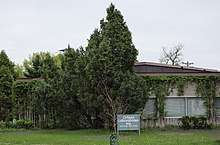Sound 80
Sound 80 is a recording studio in Minneapolis, Minnesota, United States founded by engineer Tom Jung and composer/musician Herb Pilhofer in 1969. Largely involved with local artists, the studio is best known for recording portions of Bob Dylan's Blood on the Tracks in 1974 and Cat Stevens' Izitso in 1977, as well as demo tapes for Prince's first album For You in 1977.[1][2]
| Recording studio | |
| Industry | Music |
| Founded | 1969 |
| Founder | Tom Jung and Herb Pilhofer |
| Headquarters | Minneapolis, Minnesota |
| Website | sound80 |
| sound-quality laboratory | |
| Founded | 1971 |
| Founder | Steven Orfield |
| Headquarters | Minneapolis, Minnesota |
| Website | orfieldlabs |
In 1978, Sound 80 made the first digital audio recording to win a Grammy Award—The Saint Paul Chamber Orchestra's recording of Aaron Copland's "Appalachian Spring" and "Short Symphony," and Charles Ives' "Symphony No. 3."[2][3]
In 2020, Sound 80 was placed on the National Register of Historic Places.[4]
History
Jung and Pilhofer had previously worked at the Kay Bank Studios in Minneapolis, where artists such as Dave Dudley and The Trashmen had recorded. The Sound 80 name came from advertising man Brad Morrison, who had previously named Hormel's Cure 81 ham product (supposedly while drinking Vat 69 Scotch). "The number didn't mean a thing," Pilhofer later explained. "Eighty-one was already taken [by Hormel]. Eighty just sounded right and it looked good."[5]
3M, based in neighboring Saint Paul, Minnesota, brought in a prototype digital recording system in the late Spring of 1978.[6] Nicknamed "Herbie" after Herb Pilhofer, the system was used for two recordings by the Saint Paul Chamber Orchestra and one for jazz group Flim and the BB's. One of the SPCO albums won the Grammy Award for Best Chamber Orchestra Recording in 1979. Being a prototype, it was a very bulky and finicky system. For example, it used wire wrap boards and few, if any, soldered connections. When it worked, the system had a number of good qualities. However, there was no editing ability for digital media at the time, so even minor flaws would require the whole track to be re-recorded.
Tom Jung left the company to work in New York City, but created a mobile recording unit known as Road 80, which was rented to Sound 80 studios on occasion. Jung later created the company DMP Digital Music Products, which also pushed the envelope of later digital audio technology (the company recorded the first multi-channel Super Audio CD).
In the mid 1980s the building became the home to AVC Systems, one of the largest pro audio contractors in the midwest. The basement, including the live echo chamber, was converted into a staging area for system fabrication. The main studio was converted to a showroom and office facilities. The smaller studio was rented by "Roger Dodger Music", a Minneapolis based keyboard/synthesizer dealer.
Orfield Labs

The Sound 80 building was sold around 1990, but the original recording studio still exists and is now home to Orfield Labs who operate an Eckel Industries-designed anechoic chamber. At −13 dB, it is listed as "the quietest place on Earth" by the Guinness Book of World Records. Sound 80 was listed in Guinness again in 2006 as the "Oldest Digital Recording Studio in the World".
Sound 80 today
Sound 80 continues today under the ownership of Jan Erickson. Erickson started with the company in 1969 and purchased the company in 1984. The business moved to the IDS Tower and after that to the Campbell Mithun Tower in Minneapolis where it resides today. It continues to do high quality audio recording specializing in commercial recording and small ensembles. Sound 80 has moved more and more into the areas of talent booking, payroll, and trafficking for the advertising industry, as well as developing an expertise in recording and scriptwriting for elearning programs.
Recording artists
Artists who recorded at the studio include:
- Bob Dylan
- Dave Brubeck (1978)
- Debbie Friedman
- Flamin' Ohs
- Flim & the BB's
- Michael Johnson
- Leo Kottke
- Lipps Inc., Funkytown sessions 1980
- Prince, demos (1977)
- Saint Paul Chamber Orchestra
- Skogie and the Flaming Pachucos, (1972)
- Skogie, (1973)
- Cat Stevens (1976)
- The Suburbs
- Suicide Commandos, Make a Record
- Don Voegeli
- McDonald & Sherby (1969/1974)
- Yanni (1980)
- Straight [ 1975 ]
References
- "Archived copy". Archived from the original on 2014-11-05. Retrieved 2014-11-04.CS1 maint: archived copy as title (link)
- Roise, Charlene; Gales, Elizabeth; Koehlinger, Kristen; Goetz, Kathryn; Hess, Roise and Company; Zschomler, Kristen; Rouse, Stephanie; Wittenberg, Jason (December 2018). "Minneapolis Music History, 1850-2000: A Context". City of Minneapolis. pp. 47–48. Retrieved January 1, 2020.
- https://www.facebook.com/thespco/posts/10151549157276051?_fb_noscript=1
- Bream, Jon (2020-08-12). "Minneapolis' Sound 80 studio lands on National Register of Historic Buildings". Star Tribune. Minneapolis. Retrieved 2020-07-25.
- Kenney, Dave; Saylor, Thomas (2013-10-15). Minnesota in the '70s. ISBN 9780873519007.
- "Archived copy". Archived from the original on 2014-11-05. Retrieved 2014-11-04.CS1 maint: archived copy as title (link)
- Jan Erickson Sound 80 Website
- Tom Herbers (June 8, 2005). Three Tracks, Echo, and a Bunch of Hungry Teenagers. City Pages.
- David Lander (June 2004). Tom Jung of DMP: Making Musical Sense. Stereophile.

